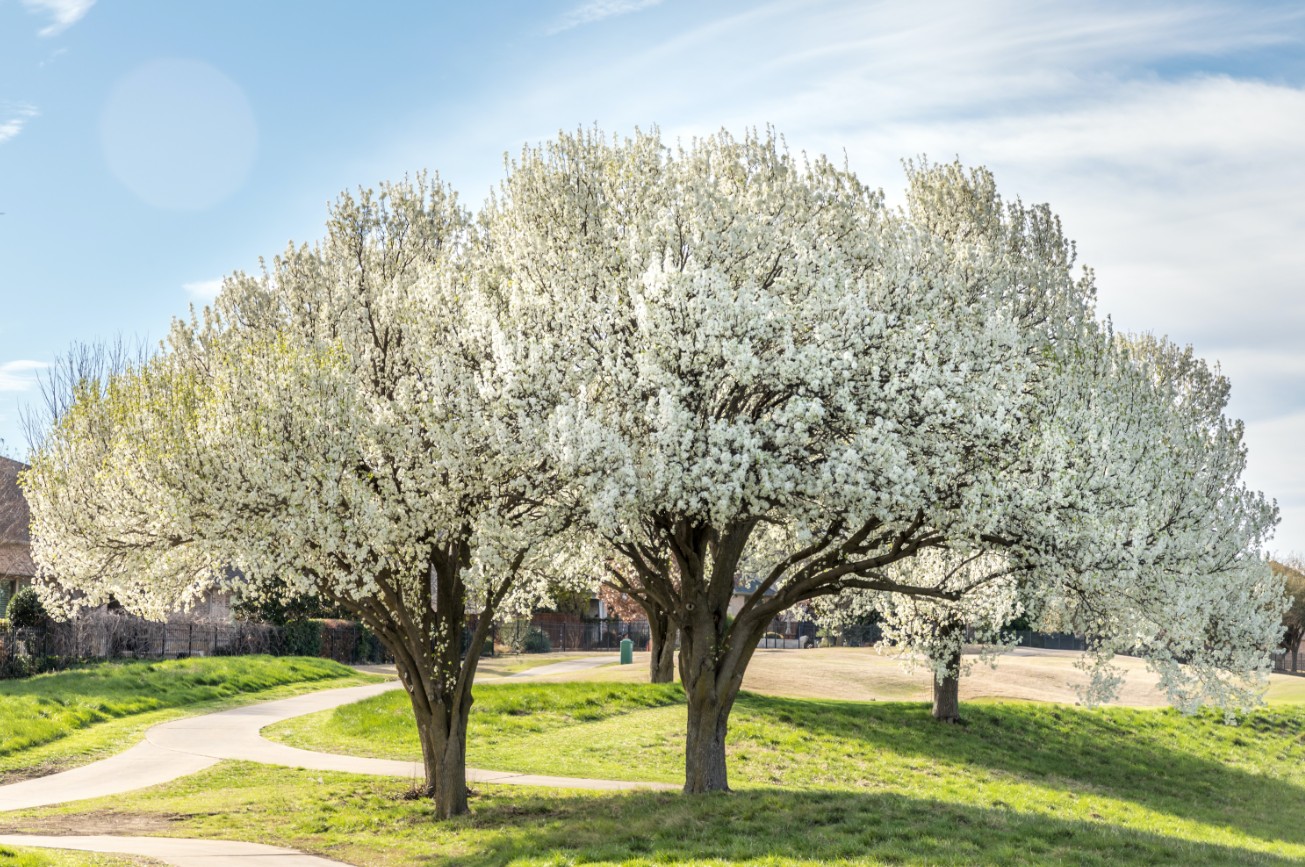
Bradford Pear Tree
The Bradford Pear Tree
A Beautiful Menace in Suburbia
The Bradford pear tree, once praised for its symmetrical shape, fast growth, and showy white spring blossoms, is now facing growing criticism from environmentalists, arborists, and even state governments. Originally introduced in the United States as an ornamental tree, the Bradford pear quickly became a favorite in landscaping for suburban neighborhoods, commercial spaces, and city planning. Its aesthetic appeal—especially its early spring bloom—made it a popular choice for decades. However, beneath its picturesque exterior lies a host of ecological and structural problems that have led to it being labeled an invasive species in several states. As awareness spreads, many are now reconsidering the role this tree plays in American landscapes. In this article, we’ll take a closer look at the origins, characteristics, benefits, and serious downsides of the Bradford pear tree and explore what makes it so controversial today.
Origin and History of the Bradford Pear Tree
The Bradford pear tree (Pyrus calleryana ‘Bradford’) is a cultivar of the Callery pear, native to China and Vietnam. It was introduced to the United States in the early 1900s as part of a program to help combat fire blight in fruit-bearing pear trees. However, it wasn’t until the 1960s that the Bradford variety began appearing widely in American landscapes. Promoted as sterile and thus non-invasive, the tree gained rapid popularity due to its symmetrical growth habit, tolerance to poor soil, and stunning spring flowers. Its compact size and ability to grow in urban conditions made it ideal for subdivisions, parking lots, and roadside plantings. For years, the Bradford pear tree was considered a “perfect” landscape tree by developers and homeowners alike.
Visual Appeal and Growth Characteristics
One of the main reasons the Bradford pear tree became so widely planted is its visual charm. In early spring, it bursts into a dense bloom of white flowers before its leaves even appear, creating a striking contrast against still-bare surroundings. These blossoms often arrive before most other trees bloom, giving the Bradford pear a spotlight moment in the early growing season. In summer, the tree has lush, glossy green leaves, and in fall, its foliage often turns a mix of reds, oranges, and purples. Additionally, the Bradford pear grows quickly—reaching up to 30 to 50 feet in height with a nearly equal spread—and develops a distinct, pyramidal shape that requires minimal pruning. For homeowners seeking fast results and seasonal interest, the Bradford pear tree seemed like a dream.
The Scent That Divides Opinions
Despite its striking appearance, the Bradford pear tree has one glaring drawback that often surprises new planters: its smell. While the blossoms may look delicate and clean, they emit a pungent, foul odor that has been compared to rotting fish or chlorine. The smell can be especially strong on warm spring days when many of the trees bloom at once. This unpleasant scent has become a defining characteristic of the Bradford pear and is often the first reason people question its continued popularity. What was once overlooked in favor of its beauty is now a major talking point for those advocating against planting this tree.
Structural Weakness and Storm Hazards
Another serious issue with the Bradford pear tree is its structural integrity. Although it grows quickly and looks robust, the tree is notoriously weak due to its branch structure. The tight, upward-angled branching pattern creates narrow crotches where limbs meet the trunk, which become increasingly brittle as the tree matures. As a result, Bradford pears are extremely prone to splitting or breaking under the weight of snow, ice, or strong winds—especially when the tree reaches 15-20 years of age. This can lead to significant property damage, injury, and costly removal. What once was a fast-growing, attractive asset can quickly turn into a liability. Cities and municipalities across the U.S. have spent millions removing these trees after storms.
Invasiveness and Environmental Impact
Perhaps the most pressing issue with the Bradford pear tree today is its impact on native ecosystems. While originally believed to be sterile, Bradford pears can and do cross-pollinate with other Pyrus calleryana varieties, producing viable seeds. Birds eat the small, hard fruits and spread the seeds widely, allowing hybrid offspring to thrive in wild and unmanaged spaces. These new pear trees grow quickly and outcompete native plants, forming dense thickets in fields, forest edges, and roadways. They are now considered invasive in several states, including South Carolina, Ohio, and North Carolina. Some states have even enacted bans on selling or planting the Bradford pear tree due to its aggressive spread and ecological disruption.
Why Some States Are Banning the Bradford Pear Tree
Due to its invasive nature and weak wood, more states are taking action to phase out the Bradford pear tree from nurseries and landscapes. South Carolina, for example, announced a full ban on the sale and distribution of Pyrus calleryana varieties starting in 2024. In Ohio, the tree has been added to the state’s invasive species list, and homeowners are encouraged to replace them with native or non-invasive alternatives. These actions represent a growing understanding of the long-term ecological costs associated with seemingly “perfect” ornamental trees. The Bradford pear tree’s initial benefits no longer outweigh the risks and environmental damage it causes.
Better Alternatives to the Bradford Pear Tree
If you’re considering planting a new ornamental tree, there are several better choices than the Bradford pear. Native trees such as the serviceberry, redbud, dogwood, and fringe tree offer similar seasonal interest without the invasive tendencies or structural issues. These trees provide beautiful spring blooms, attractive fall foliage, and important habitat for pollinators and birds. They also integrate better with native ecosystems, helping restore biodiversity and prevent the spread of invasive plants. Choosing the right tree involves thinking long-term, not just about quick growth or early spring flowers.
Why Landscapers and Homeowners Still Use It (and Why They Shouldn’t)
Despite all the warnings and bans, the Bradford pear tree is still planted in some areas. Part of the reason is availability—many nurseries still stock them—and part of it is the tree’s quick growth and low initial maintenance. Some landscapers default to it because of familiarity, while homeowners may simply not be aware of its long-term issues. However, with increased education and policy change, many professionals now refuse to install Bradford pear trees in new projects. Public awareness campaigns are beginning to make a difference, but it will take time to reverse decades of overplanting.
How to Remove a Bradford Pear Tree Safely
If you have a Bradford pear tree on your property and are considering removal, it’s important to do it correctly. Mature trees often require professional removal due to their size and the risk of damage during felling. Stump grinding or chemical treatments may be necessary to prevent suckers from sprouting back. In some regions, state or city programs may even offer tree replacement incentives to encourage the removal of invasive species like the Bradford pear tree. Always check local ordinances before removal, especially if your neighborhood has landscaping regulations.
Wildlife and the Bradford Pear Tree
While the Bradford pear does attract some birds that feed on its small fruit, the tree offers limited ecological value overall. The fruits are not highly nutritious, and the flowers bloom too early to support many native pollinators. Furthermore, the dense thickets formed by escaped Bradford pears in wild areas can crowd out native shrubs and trees that birds and insects depend on. By replacing Bradford pear trees with native species, homeowners and cities can provide more sustainable and beneficial habitat for local wildlife.
Misconceptions and Myths About the Tree
Many people still believe that the Bradford pear tree is sterile and safe to plant because that’s how it was marketed in the past. This myth persists despite clear evidence that these trees are now highly invasive. Another common misconception is that pruning can “fix” the structural weaknesses of the Bradford pear tree. While some pruning may delay breakage, it doesn’t eliminate the risk, especially as the tree matures. Education is key to correcting these misunderstandings and helping people make better planting decisions.
Final Thoughts on the Bradford Pear Tree
The Bradford pear tree is a textbook example of how a tree can go from hero to villain. Initially celebrated for its beauty and convenience, it’s now regarded by many as an environmental threat and structural hazard. Although it served a purpose during its early introduction, the long-term impacts have proven to be too costly—both ecologically and economically. By removing existing Bradford pear trees and avoiding new plantings, property owners can play a part in restoring balance to local ecosystems. The time has come to replace the Bradford pear tree with smarter, more sustainable alternatives.
FAQs About the Bradford Pear Tree‘s
Q: Are Bradford pear trees invasive?
Yes, they are now classified as invasive in multiple U.S. states due to their ability to cross-pollinate and spread aggressively.
Q: Why do Bradford pear trees smell bad?
Their white blossoms emit a strong odor, often compared to rotting fish, which is a natural byproduct of their chemical makeup.
Q: How tall does a Bradford pear tree‘s grow?
It typically reaches 30 to 50 feet in height with a similar spread, making it appear large and lush in landscapes.
Q: Can I legally plant a Bradford pear tree’s?
That depends on your location. Some states have banned or restricted their sale. Check with your local agricultural extension office.
Q: What are good alternatives to the Bradford pear tree’s?
Native options like serviceberry, dogwood, or redbud are excellent choices that offer beauty without ecological harm.



